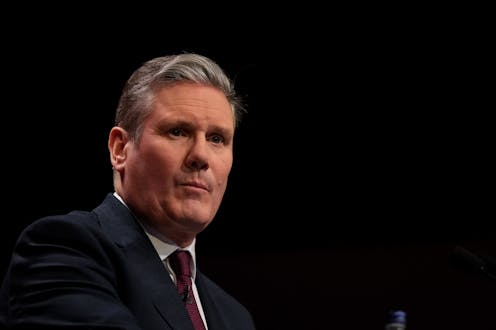
I arrived in the UK at the beginning of 1997, so I experienced the rush of hope and giddiness that caught the country as Labour swept into power after a decade of austerity. There was an appreciation of British creative output at its core. These were the years of Britpop, Ginger Spice wearing the union jack at the Brit Awards and great British films like Trainspotting and Notting Hill.
Fast forward to 2024, and things are very different. In March, Labour’s own analysis showed that 40% of the Britons nominated for prizes at major cultural awards were educated at private schools – a disproportionate amount. Meanwhile, mainstream school headteachers have increasingly raised concerns that “cost pressures are forcing them to drop more expensive but less popular subjects such as art and design”.
So, unsurprisingly, creative education is embedded in much of Labour’s 2024 manifesto. It says that “every child should have a broad curriculum”, including creative skills. There is a section on page 86, seven paragraphs long, that talks about access to arts, music and sports. It is good to read that Labour understands the need for a talent pipeline that feeds the huge potential for growth in the creative industries. But the detail is lacking.
This article is part of our State of the Arts series. These articles tackle the challenges of the arts and heritage industry – and celebrate the wins, too.
The manifesto promises that a Labour government will implement a creative industries sector plan, promising growth in film, music and gaming, as well as supporting public broadcasters.
It will give a commitment to arts education up to the age of 16 while ensuring “accountability measures to reflect this”. It will launch a national music education network. It will crack down on ticket resales. And it will require museums to increase loans to communities across the country. But that’s all there is.
The suggestions of loading stressed teachers with additional accountability measures, or BBC officials being tasked with commissioning “distinctively British content” (what exactly is meant by “distinctive”, here?) don’t fill me with optimism.
The manifesto’s promises feel like a checkbox exercise, nodding to various culture headlines from the past years, to garner broader support. Yet it is quite thin on concrete policy. And it lacks clear ideas on how to make use of the immense potential of the UK’s creative, cultural and heritage sectors.
This is a serious omission, especially considering that just a few months ago, Labour launched a 19-page plan dedicated to precisely that.
Culture 3.0
Arguably, this 19-page plan was too hung up on what Italian professor of culture, Luigi Sacco, coined “culture 2.0”. Culture 2.0 describes types of arts and culture that can be digitally replicated and are characterised by large audiences and significant turnover, such as the music and film industries. Crucially, it almost always involves intellectual property (IP) and copyright exploitation.
In being hung up on culture 2.0, the Labour of 2024 has much in common with the ideas they won the election in 1997. In the run-up to those elections, Labour homed in on a definition of the creative industries that centred on intellectual property and copyright. Labour’s 1997 creative industry strategy was very much about culture 2.0, apt then for a highly marketised creative sector in music and film, leading to the cultural moment of the late 90s, now known as Cool Brittania.
However, focusing only on the IP-related aspects of the creative economy left cultural organisations somewhat in the shadows. This tension between a predominantly for-profit sector and a predominantly not-for-profit sector is still here today in Labour’s commitments and ideas around a creative economy.
And apart from arts education, this stance does not differentiate itself very much from the Creative Industry Sector Deal published by the Conservative government in 2018 or its update in 2021, or its current Creative Industry Sector Vision from 2023.
Of course, there is still a lot of money to be made in copyright-centric industries. But there is evidence that business models and creative professionals increasingly desire and demand co-creation, co-production and user-generated experiences and content. This is culture 3.0. Culture 3.0 is often seen as “democratic” with constantly shifting roles of content producers and users. Today, I might listen to a podcast; tomorrow, I am recording one.
The economic and social value of culture 3.0 comes through sales and participation. With no predetermined market channel bottlenecks, culture ceases to be an aspect of free time but becomes entrenched in the fabric of everyday life. Technology, collaborative tools and digital connectivity have made these forms of cultural engagement much more commonplace and with its widely available tools of production, mass distribution of content happens largely without mediators and gatekeepers.
Cultural devolution and culture-led regeneration, as well as levelling-up all fit into a culture 3.0-focused industrial strategy, but this is missing from the Labour manifesto. Culture 3.0 also provides a playground for new technology, like artificial intelligence and blockchain. To push this technology back into a culture 2.0 framework is setting businesses up to follow dead ends.
I welcome Labour’s commitment in the area of primary and secondary school arts education. But beyond arts provision in schools, we cannot look back to 1997’s creative industry strategy to increase innovation and productivity. This worked 20 years ago but will not do much longer. We have lost our creative mojo in the UK – and I am not certain that this manifesto will get it back.
![]()
Carola Boehm is Professor of Arts and Higher Education at Staffordshire University, a co-chair of a regional cultural compact Stoke Creates CIC and a trustee of ArtUK. She has previously received funding from Arts Council England, European Commission, UKRI and the Leverhulme Trust.



